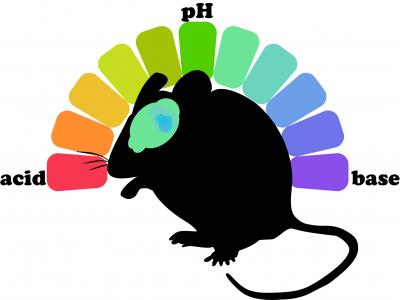Researchers from the National Institute for Physiological Sciences in Okazaki and Toyohashi University of Technology in Toyohashi develop a probe to measure changes in brain pH in mice during exposure to visual stimuli

Credit: Ikuko Takeda
Okazaki, Japan – Although a number of techniques are able to track changes in pH in the brain, precise measurements have not previously been possible. Now, however, researchers in Japan have developed a novel method for examining brain pH that may lead to new information about the role of pH in brain signaling.
In a study published this month in Nature Communications, researchers from the National Institute for Physiological Sciences in Okazaki and Toyohashi University of Technology in Toyohashi revealed their new design for a probe to measure brain pH with increased spatial and temporal accuracy compared with previous techniques.
The recent finding that pH plays a role in neurotransmission indicates that pH changes may have important consequences for normal brain function and pathological brain conditions. However, existing methods for measuring brain pH either have low spatial and temporal resolution, such as magnetic resonance imaging, or are limited in that they are only able to measure pH at a single point, i.e., microelectrodes. As a result, the detailed involvement of pH in neurotransmission remains unexamined. To address this, researchers at the National Institute for Physiological Sciences in Okazaki and Toyohashi University of Technology in Toyohashi developed a special sensor to examine pH activity at a neural circuitry level.
“The new proton image sensor device was based on our previous sensor, but was speci?cally optimized for in vivo brain analyses in mice,” says Hiroshi Horiuchi, one of the lead authors of the study. “This enabled us to examine changes in brain pH, which is measured according to proton concentration, during exposure to stimuli in a visual experience task,” adds Masakazu Agetsuma, the other lead author of the study.
The new device was designed to be smaller than the previous probe so that it would cause minimal damage to the brain regions surrounding the probe. When the researchers tested the device, they found that the modifications did not appear to impair functionality.
“The data indicate that our biosensor can measure changes in pH that occur on a scale of micrometers and milliseconds across a wide area,” explains Kazuaki Sawada, co-corresponding author. “As a result, it was possible to use the probe to correlate distinct spatial patterns of pH changes in the mouse primary visual cortex with specific visual stimulus patterns.”
The proton image sensor was able to uncover distinct patterns of pH changes in the primary visual cortex that were induced by each of eight different stimulus patterns.
“That we found alterations in pH at a micrometer-scale resolution suggests that pH changes may be involved in ?ne-tuning brain activity,” says Junichi Nabekura, senior author. “This may be clinically important given that patients with psychological disorders, such as schizophrenia and bipolar disorder, have been found to have abnormal brain pH levels.”
That the probe was successfully used to observe the biological dynamics of pH indicates that it may have potential applications in a wide range of biological investigations. Particularly, the proton image sensor may be useful for examining the relationship between cellular pH dysfunction and various pathologies.
###
Media Contact
Junichi Nabekura
[email protected]
81-564-557-851
Original Source
https:/
Related Journal Article
http://dx.




